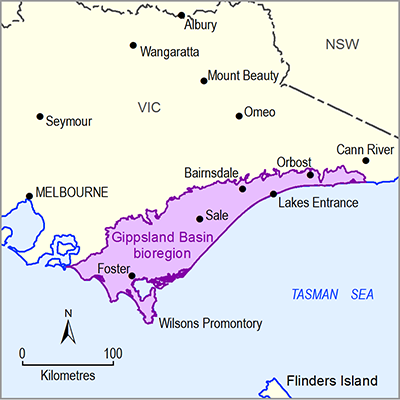- Home
- Assessments
- Bioregional Assessment Program
- Gippsland Basin bioregion
- 1.1 Context statement for the Gippsland Basin bioregion
- 1.1.5 Surface water hydrology and water quality
Summary
The Gippsland Basin bioregion intersects four Australian Hydrological Geospatial Fabric (Geofabric, Bureau of Meteorology, 2013) River Regions: South Gippsland River Region, Mitchell–Thomson River Region, Snowy River Region and East Gippsland River Region. The area of the Gippsland Basin bioregion is 14,636 km2 of which 52% is included in the Mitchell–Thomson River Region followed by 39% in the South Gippsland River Region, 7% in the Snowy River Region and 2% in the East Gippsland River Region.
The south-western part of the Gippsland Basin bioregion is part of the South Gippsland River Region. The surface water systems of this river region include several rivers (e.g. Tarwin River, Albert River and Tarra River) and creeks (e.g. Merriman Creek and Bruthen Creek) as well as freshwater and salinewater wetlands. A notable feature of the system is its floodplain providing rich agricultural land as well as areas of high conservation value, such as Wilsons Promontory, Corner Inlet and the Nooramunga Marine and Coastal Park. Major watercourses in this river region originate within the Gippsland Basin bioregion and discharge to inlets through to the ocean. The majority of them are unregulated. There have been a number of large flood events (e.g. in 1934, 1990, 2011 and 2012). Streamflow in the South Gippsland River Region has not yet been affected by major diversions or storages. Irrigation is not widespread due to the relatively reliable rainfall all across the river region. Water quality indicators such as electrical conductivity (EC) and turbidity are very high in part of the river region compared to other river basins in the Gippsland Basin bioregion. However, these are still within water quality objective values for the South Gippsland River Region.
Much of the Gippsland Basin bioregion overlaps the Mitchell–Thomson River Region. The surface water systems of this river region include several large rivers including the Latrobe River, Thomson River, Macalister River, Mitchell River and Tambo River as well as wetlands and saltwater pans. In the north, river basins are characterised by the naturally forested Eastern Highlands. The lower part of the river region features cleared agricultural land. The majority of the watercourses in this river region are unregulated, except for the lower parts of the Latrobe River, Thomson River and Nicholson River. The amount of flow regulation on most of these systems is however relatively small. A large proportion of available surface water in this river region is allocated for the environment, with the remainder allocated through bulk entitlements and licensed diversions. Water quality indicators vary between watercourses; however, both EC and turbidity are within the limits of water quality objectives.
A small proportion of the Gippsland Basin bioregion is located in the Snowy River Region. The surface water system of this river region includes several large rivers and creeks as well as wetlands on the floodplain. In the north, the river region is characterised by the naturally forested Eastern Highlands. All major watercourses in this river region originate outside the Gippsland Basin bioregion and discharge to the sea. The watercourses in the Snowy River Region are unregulated, except for the Snowy River. There have been a number of significant flood events including in 1964, 1970, 1983, 1991, 2007, 2011 and 2012. Streamflow in the Snowy River Region has been affected by dams and diversions. There is a significant reduction in river flow after the construction of four large dams in the mid-20th century as part of the Snowy Mountains Scheme. Water quality for major watercourses in the Snowy River Region is generally good. Both EC and turbidity are less than the trigger values of 500 µS/cm and 10 NTU (Nephelometric Turbidity Unit) respectively.
The eastern end of the Gippsland Basin bioregion is part of the East Gippsland River Region. The surface water system of the river region includes four large rivers and several creeks as well as freshwater and salinewater wetlands. Consistent with the high proportion of naturally forested land and the absence of major water storages, the majority of the streams in this river region maintain natural or near natural flow regimes. There have been a number of significant flood events in the past. The most recent major flood events occurred in the river region in 1990, 1998 and 2007. A number of lesser floods also occurred through this period, including those in 2010 and 2011. Water quality indicators for all major watercourses in the East Gippsland River Region are relatively good. The EC values are much lower than the water quality objective trigger value. Turbidity lies within the acceptable range.

